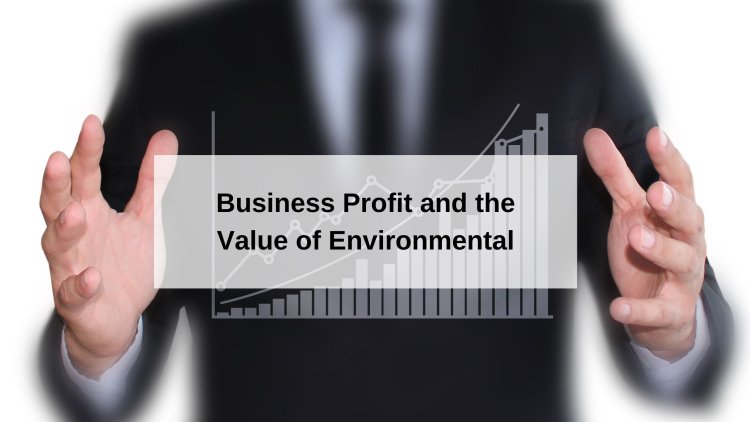Business Profit and the Value of Environmental Safety Practices
Discover the correlation between business profit and environmental safety practices. Learn how sustainable strategies can enhance your bottom line while safeguarding our planet

As the world grows more conscious of environmental issues, businesses are increasingly focusing on sustainability and environmental safety practices. The traditional view that profit and environmental responsibility are at odds is evolving. Companies are recognizing that embracing environmental safety practices can drive profitability, create long-term value, and build a positive corporate image. This blog post explores the relationship between business profit and environmental safety practices, examining why integrating sustainability into business operations makes financial sense.
The Shift Toward Environmental Sustainability in Business
In recent years, environmental sustainability has become a crucial consideration for businesses worldwide. As public awareness of environmental issues like climate change, resource depletion, and pollution grows, companies are under greater pressure to adopt environmentally responsible practices. This shift is driven by several factors:
-
Consumer Expectations: Modern consumers are increasingly eco-conscious, preferring to do business with companies that demonstrate environmental responsibility. Companies that fail to meet these expectations risk losing market share to more sustainable competitors.
-
Regulatory Compliance: Governments around the world are enacting stricter environmental regulations. Compliance with these laws is not only a legal obligation but also a way to avoid fines, penalties, and reputational damage.
-
Investor Demands: Investors are paying closer attention to environmental, social, and governance (ESG) factors when evaluating companies. Businesses with robust environmental safety practices are more attractive to socially responsible investors.
-
Reputation and Brand Image: A strong commitment to environmental sustainability can enhance a company's reputation and brand image. This positive perception can lead to increased customer loyalty, partnerships, and business opportunities.
The Business Case for Environmental Safety Practices
Contrary to the notion that environmental safety practices are a financial burden, many companies have found that integrating sustainability into their operations can lead to tangible benefits. Here are some ways in which environmental safety practices contribute to business profit:
-
Cost Reduction and Efficiency: Implementing environmentally friendly practices can lead to significant cost savings. For example, reducing energy consumption, minimizing waste, and optimizing resource use can lower operational expenses. Companies that embrace energy-efficient technologies and sustainable processes often find that they can achieve more with less.
-
Risk Mitigation and Compliance: Adopting environmental safety practices helps businesses comply with regulations, reducing the risk of legal issues and penalties. This proactive approach also mitigates risks associated with environmental accidents, which can be costly in terms of cleanup, fines, and damage to reputation.
-
Innovation and Competitive Advantage: Companies that prioritize environmental safety often drive innovation. By investing in sustainable technologies and practices, businesses can develop new products, services, and processes that give them a competitive edge. Innovation in sustainability can also lead to intellectual property and new market opportunities.
-
Employee Engagement and Retention: A company committed to environmental safety tends to attract and retain employees who share those values. A workforce engaged in sustainability initiatives is more motivated, leading to higher productivity and lower turnover rates. Employees are also more likely to feel proud of their workplace, contributing to a positive corporate culture.
-
Access to Capital and Investment: As investors prioritize ESG factors, companies with strong environmental safety practices find it easier to attract capital and investment. Sustainable businesses are often viewed as lower risk, making them more appealing to investors seeking long-term stability.
-
Brand Loyalty and Customer Retention: Companies that prioritize environmental safety build stronger relationships with customers. A commitment to sustainability resonates with eco-conscious consumers, leading to increased brand loyalty and customer retention. These customers are also more likely to recommend sustainable companies to others, driving word-of-mouth marketing.
Examples of Companies Leading in Environmental Safety Practices
Several companies have demonstrated that environmental safety practices and business profit can go hand in hand. These examples showcase how sustainability can be a driving force for financial success:
-
Patagonia: Known for its commitment to environmental sustainability, Patagonia has built a loyal customer base by promoting eco-friendly practices. The company's "Worn Wear" program, which encourages customers to repair and reuse their products, aligns with the values of environmentally conscious consumers. Patagonia's approach has not only enhanced its reputation but also driven business growth.
-
Unilever: Unilever's Sustainable Living Plan focuses on reducing the company's environmental footprint while increasing positive social impact. By setting ambitious sustainability goals, such as halving its environmental impact by 2030, Unilever has achieved cost savings, attracted socially responsible investors, and enhanced its brand image.
-
Tesla: Tesla's commitment to electric vehicles and renewable energy has positioned it as a leader in sustainability. The company's innovative approach to transportation and energy storage has driven significant financial success. Tesla's focus on reducing carbon emissions resonates with consumers and investors seeking sustainable solutions.
-
IKEA: IKEA's sustainability strategy includes sourcing renewable materials, reducing energy consumption, and promoting circular economy practices. By implementing these initiatives, IKEA has achieved cost savings, improved its supply chain resilience, and strengthened its brand reputation.
Strategies for Implementing Environmental Safety Practices
For businesses looking to embrace environmental safety practices, there are several strategies to consider:
-
Assess Environmental Impact: Start by conducting a comprehensive assessment of the company's environmental impact. This assessment should identify areas for improvement, such as energy usage, waste generation, water consumption, and emissions.
-
Set Sustainability Goals: Establish clear sustainability goals that align with the company's values and business objectives. These goals should be measurable and time-bound, allowing the business to track progress and demonstrate commitment to sustainability.
-
Engage Stakeholders: Involve stakeholders, including employees, customers, suppliers, and investors, in the sustainability journey. Engaging stakeholders fosters a sense of ownership and helps generate support for environmental safety practices.
-
Invest in Sustainable Technologies: Embrace innovative technologies and practices that promote sustainability. This could include energy-efficient equipment, renewable energy sources, waste reduction initiatives, and sustainable sourcing practices.
-
Implement a Sustainability Management System: A sustainability management system helps businesses organize, track, and improve their environmental safety practices. This system should include processes for monitoring, reporting, and continuous improvement.
-
Communicate and Educate: Effective communication and education are essential for promoting environmental safety practices. Businesses should communicate their sustainability efforts to customers, employees, and other stakeholders. Educational programs and training can also help build a culture of sustainability within the organization.
Environmental safety practices are no longer a luxury; they are a strategic imperative for businesses seeking to thrive in a rapidly changing world. By embracing sustainability, companies can reduce costs, mitigate risks, drive innovation, and build strong relationships with customers and investors. The business case for environmental safety practices is clear: it's not just about doing good for the environment; it's about creating lasting value and profitability.
As businesses continue to evolve, those that prioritize environmental safety practices will be better positioned for success in the long run. By integrating sustainability into their operations, businesses can achieve a competitive advantage, foster brand loyalty, and contribute to a more sustainable future.
What's Your Reaction?




















